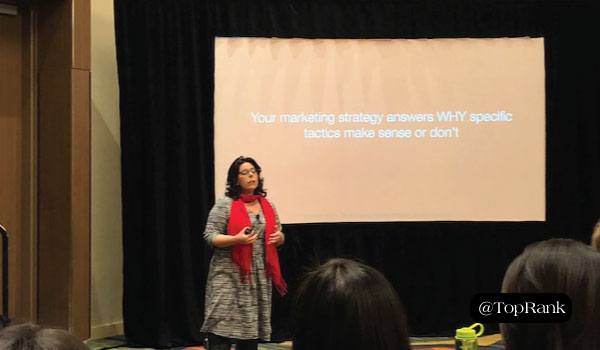
Planning for 2019 is well underway and most marketers are asking themselves if their plan will really impact results. Many marketers start with goal revenue numbers. And from there, work backwards to corresponding goals for leads, channels, tactics and audience targets. Unfortunately, the words that no marketer wants to hear ring clear from leadership: do more with less budget.
So how can you do more with less? How can you ensure success in the ever-changing landscape of the B2B consumer?
Samantha Stone, the Founder of the Marketing Advisory Network, suggests that marketers flip the usual model for 2019 planning. If you start with marketing strategy, you can stop doing “more” and instead focus on a few tactics your team executes incredibly well, that can have a significant impact on the organization.
But let’s face it, often it can be tough to stay focused on strategy. Fortunately, Samantha offers 3 tips to create a high-impact marketing strategy (regardless of where you’re at).
#1 – Start with honest differentiation
Establishing your competitive differentiator seems like marketing 101. But something that seems simple, can be overlooked when working backward from revenue numbers. And can result in sales and marketing messages that miss the mark with your target audience.
One mistake brands make is creating a competitive differentiator based on what they think is most valuable. Instead, this is a good opportunity to identify what customers and prospects consider to be the differentiator.
At the core, differentiators should be:
- Unique to the brand, compared to competitors
- Meaningful to the customers you serve (solving a real pain point)
- Durable or able to make a measurable impact (cost, time spent, etc.)
- Evidence-based, with the data to back it up
Once you have your differentiator hypothesis you must validate it with the correct audience (your customers and prospects). Remember, your differentiator can’t be something you, your boss or CEO feels; it has to be something your target audience believes in.
Spend the time to test your hypothesis with customers or potential buyers and ask is your messaging:
- Compelling?
- Credible?
- Impactful in their organization?
#2 – Close the Sales & Marketing Gap
Many brands are still facing a disconnect between marketing and sales. Sure, there may be more conversations about lead quality and frequently asked questions. But fundamentally, most marketers feel like they’re delivering a flurry of activity; clicks, leads or social shares. But to sales, that activity may feel less like a flurry and more like a trickle.
The 2016 B2B Sales and Marketing Collaboration Study uncovers some unexpected sales and marketing behaviors which may drive this perception disconnect:
- 66.7% of sales teams report that they are NOT rewarded for supporting marketing objectives. They are incentivized only for closing the deal, not all of the critical activity that happens nurturing a prospect to talk to the sales team.
- 57% of organizations report that less than 85% of leads delivered by marketing are followed up with by sales.
This is likely because a portion of the leads delivered are not the right person at the right stage of the buying cycle.
How do you fix the disconnect?
- Go directly to buyers. Breaking down the barrier between marketers and buyers results in better marketing communications, which resonates more with buyers (and sales).
- Leverage a variety of formats when communicating to sales. This matters more than the frequency of the meeting (i.e. email, centralized repositories, virtual and in-person meetings,etc.).
- Create service level agreements between sales and marketing. This may include:
- Lead scoring criteria
- Time from lead assignment to follow up
- Collection of win/loss data
- Number of new contacts added to the database by sales
#3 – Stop Being Accountable for Activity. Measure Impact.
As B2B marketers, we talk a lot about leads. And leads may be easy to generate; with the right campaign, the right gated asset or the right event. But we aren’t really after leads; we’re after opportunities. In order to focus on the right types of activities, we need to ensure we are looking at the right metrics.
So rather than leads; focus on metrics which are meaningful to the bottom business line:
- Financial (Pipeline created, win rate)
- Advocacy (# of referrals)
- Length of Buying Process (Discovery Call to Demo, Proposal to Close)
Start with Strategy to Drive Impact
For 2019 planning let’s focus on strategy first. By refining our focus on a meaningful and unique value proposition; we can better align with sales to drive the right leads and then finally set goals for metrics that matter.
How are you setting goals for 2019 planning?


